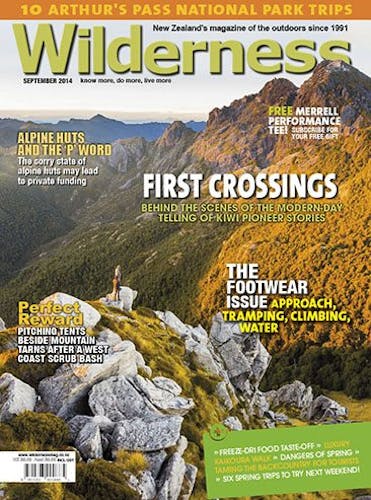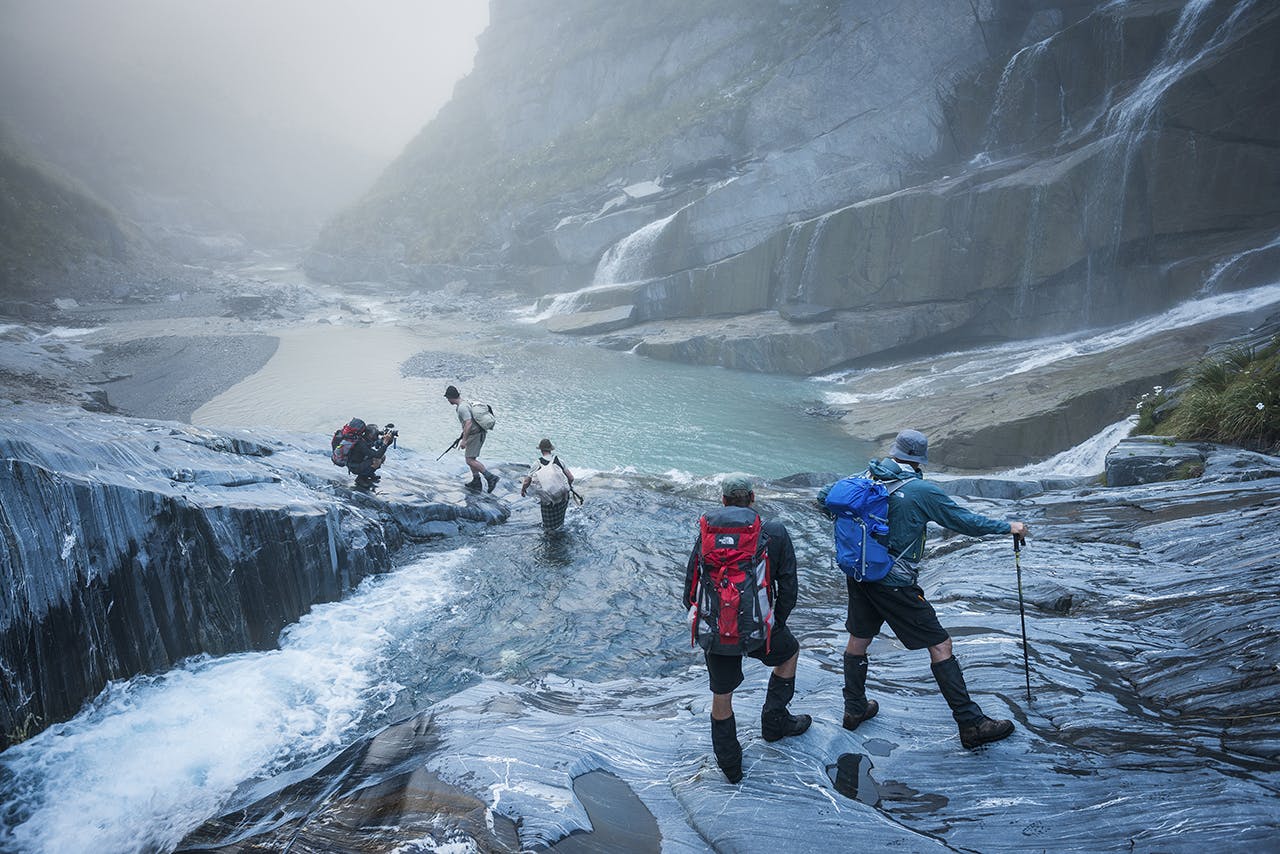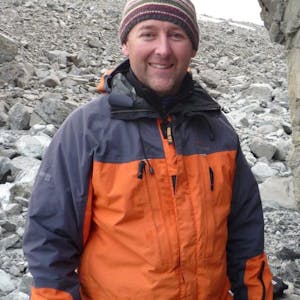What’s it like to film a TV show about some of the most audacious explorations of New Zealand’s backcountry? Wilderness goes behind the scenes of First Crossings and Intrepid NZ
For 12 hours we’d been deep underground, damp and in darkness, surrounded by rushing water and pushing the limits of our energy levels on minimal rations. It had taken a concerted team effort, all of us passing camera and lights through the maze of Harwoods Hole. Everything had seemed rushed, but somehow we’d finally emerged onto a warm karst tallus slope to soak up the last of the Golden Bay daylight. After the darkness of the cave, the sky seemed bluer and the forest greener. But the day wasn’t over yet. We still faced another three hours of lugging gear uphill to where, with a little bit of luck, the producer would be waiting with hot food.
Plenty of time for me to reflect on how I came to be there.
A couple of years earlier I received a call from a producer at television production company Eyeworks, saying Geoff Spearpoint and I had been recommended as guides for a Southern Alps trip. The idea was to film two modern day adventurers – Jamie Fitzgerald and Kevin Biggar – as they retraced the journeys of pioneer explorers using the same gear and experiencing many of the same hardships. The show would be called First Crossings (which this year evolved into Intrepid NZ).
It was my first TV job and the experience is perhaps best summed up by Jock Fisher, one of the subjects for the episode about deer cullers, who emailed me a copy of his 1950s work contract with the Department of Internal Affairs. ‘Working hours will be as decided from day to day by the Field Officer or the man who is, for the time being, in charge of the party, and they will include such hours or times of the day as may be necessary to achieve the best results,’ it read. ‘They may commence before daylight and end after dark, so that the early morning and late evening can be taken advantage of.’
Replace ‘Field Officer’ for ‘Director/Producer’ and this could just as easily have been our work contract. If you were lucky enough to be part of the small team making these shows, it went without saying that you willingly signed up to irregular hours and long days.
By early December 2011, crew and guides arrived at Lake Heron Station to film the first show, the story of Whitcombe and Lauper, who pioneered a new route over the Southern Alps in 1863. Despite having a good plan, we all had questions about how it would pan out. The world of Auckland-based TV was about to collide with the mountain world of the Southern Alps.
I was the ‘fixer’, a job title I was previously unaware of. Along with the producer, I had to get everything needed for the filming – food, accommodation, logistics and guides – in place at the right time so the film crew could concentrate on shooting footage. Geoff and Hugh van Noorden were the guides.
On the second day I got my first lesson in filming. “It’s just an easy 3-4 hour walk from Whitcombe Pass to Neave Hut,” I confidently promised the TV crew. We arrived 10 hours later with Team Auckland having gained their West Coast scrub-bashing wings and the guides being a little wiser about how much time it takes to film each sequence.
It goes without saying that making TV of a journey is not the same as the actual journey itself, but there was still a surprising level of severity involved. While we used helicopters to ferry gear between camps or huts, a fair amount of on-the-ground travel with cumbersome film gear was required. Sometimes, as in the case of the Motu River, the whole journey was completed at river level; nearly 80km of gorges rafted in a small wooden boat. On more than one occasion, the safety crew watched Kevin and Jamie go through multiple takes until they were utterly exhausted. Dressed in the relative warmth and comfort of modern gear, I often thought ‘rather you than me’.
Over three years and 21 episodes, I came to admire all the skills that somehow, serendipitously, came together. The ‘soundie’ who just happens to have done a bit of sailing and can improvise a solution to help the art department out of a tight spot. The art department guy who can quickly build a replica boat in an unfamiliar workshop. The cameraman who pushes himself physically and mentally to get that special shot. The director who can clearly articulate the essence of the journey, using succinct and direct language. The producer who, armed with a smartphone, can quickly solve any last minute crisis. The alpine guide who can pull a team through the mountains in a tight weather window one day, then rebuild a critical prop the next.
For their part, Kevin and Jamie had been chasing overseas adventures and had precious few miles under their belts in the New Zealand mountains. But what they lacked in experience they more than made up for with determination. They were quick learners on every new thing thrown at them, soaking up years of knowledge and experience in a remarkably short time.
But the most impressive quality they demonstrated was the ability to communicate the story while on the move – which is harder than you might think – and by the end of seven days, come to some sort of meaningful conclusion. While much of the show had to be reasonably well planned in advance, the end was deliberately left open. This type of story telling is not a ‘re-creation’, but Jamie and Kevin’s journey through the same landscape.
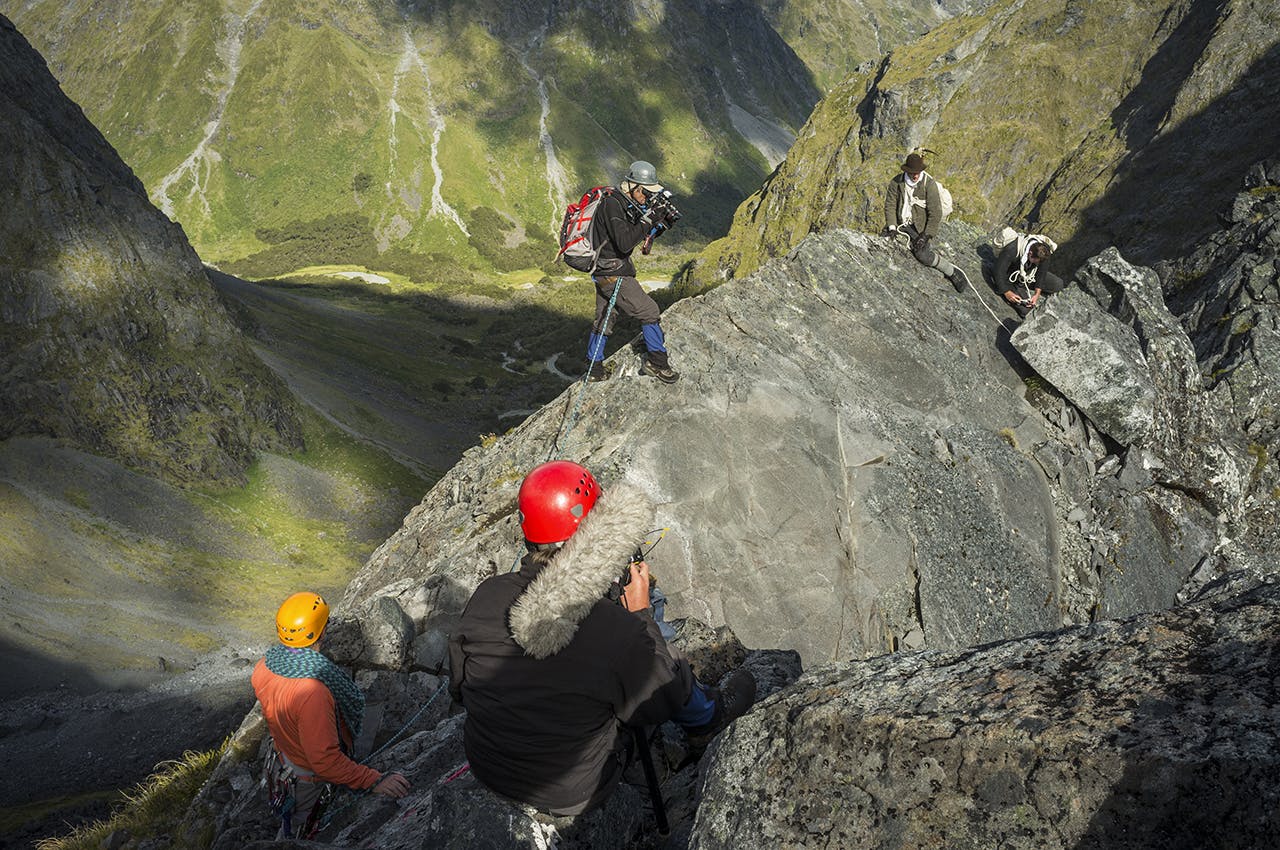
Filming a scene for the Grave-Talbot story on Homer Saddle. Photo: Rob Brown
Telling a story on television is not as easy as it first appears, especially when trying to compress into 44-minutes a journey that may have taken place over weeks or months. How to give a sense of actually being there with the early explorers? How to tell a story that may have involved a great deal of misery and hardship without viewers switching over to something a little less draining? Sound, images and storylines have to come together in a pretty succinct way. You can’t simply add extra minutes to cover everything you might want to. Perhaps no other medium for story-telling has such a disciplined format.
From my perspective, I was just thankful that Eyeworks and TVNZ had taken an interest in these wonderful historical stories. Modern digital cameras were not only capable of delivering broadcast quality footage, but made feasible the idea of a small budget and team. Perhaps too, filming techniques back then would have lacked the immediacy required to put you right there in the picture with Kevin and Jamie.
Inevitably, one 44-minute show is ‘a’ history of events rather than ‘the’ history. In the case of something like Thomas Brunner and Kehu’s epic 500-day-plus exploration of the West Coast, one device we used was to explore the possibility of what it could have been like for them to make more use of the Buller River to speed their journey. This was partly because the road no longer makes the Buller the wilderness it was, while at the same time compressing some of the journey.
This part of the process was perhaps the most interesting to me. For years, I had read these stories in books and had got used to the type of narrative told on the page. Seeing the story from a different perspective, using a new medium, reignited my interest and sometimes changed my thinking about the history. The Barrington story felt that way for me. On the page, his epic six-month search for gold comes across as a heroic tale of survival. But as the week of filming went by, I was left more and more bemused by the insanity of the way Barrington was so convinced the gold was there he went back with 50 hungry miners in a mad expedition via the West Coast.
Selecting stories involved a bit of brain storming pre-season to come up with a shortlist. Guides doubled as story researchers and the producer and director had an innate feel for which stories would translate well to TV. Of necessity, we had to abandon some promising story ideas when it became apparent they couldn’t be adapted to TV.
Over the course of the series, an increasing number of ‘unknown’ stories came to the surface. Who would have thought Jack Holloway and his Olivine exploration would feature for a primetime TV audience? Others simply had to be told, like Charlie Douglas and Gerhard Mueller in the Arawhata and Captain Musgrave and the Grafton castaways on the Auckland Islands. In many ways, it’s remarkable these hadn’t made it into mainstream general knowledge beforehand.
I had lived with the stories told in the First Crossings and Intrepid NZ series for years, knowing them as an integral part of our backcountry lore. To see these brought to life in a new way has been immensely rewarding.
Time will tell whether the show has helped a new generation absorb these stories, or perhaps even inspired them to go out on their own journeys.
But what’s for certain, every time Jamie and Kevin stepped out in their damp woollen clothes they paid tribute to those men and women who pioneered our wildest country.
History repeats
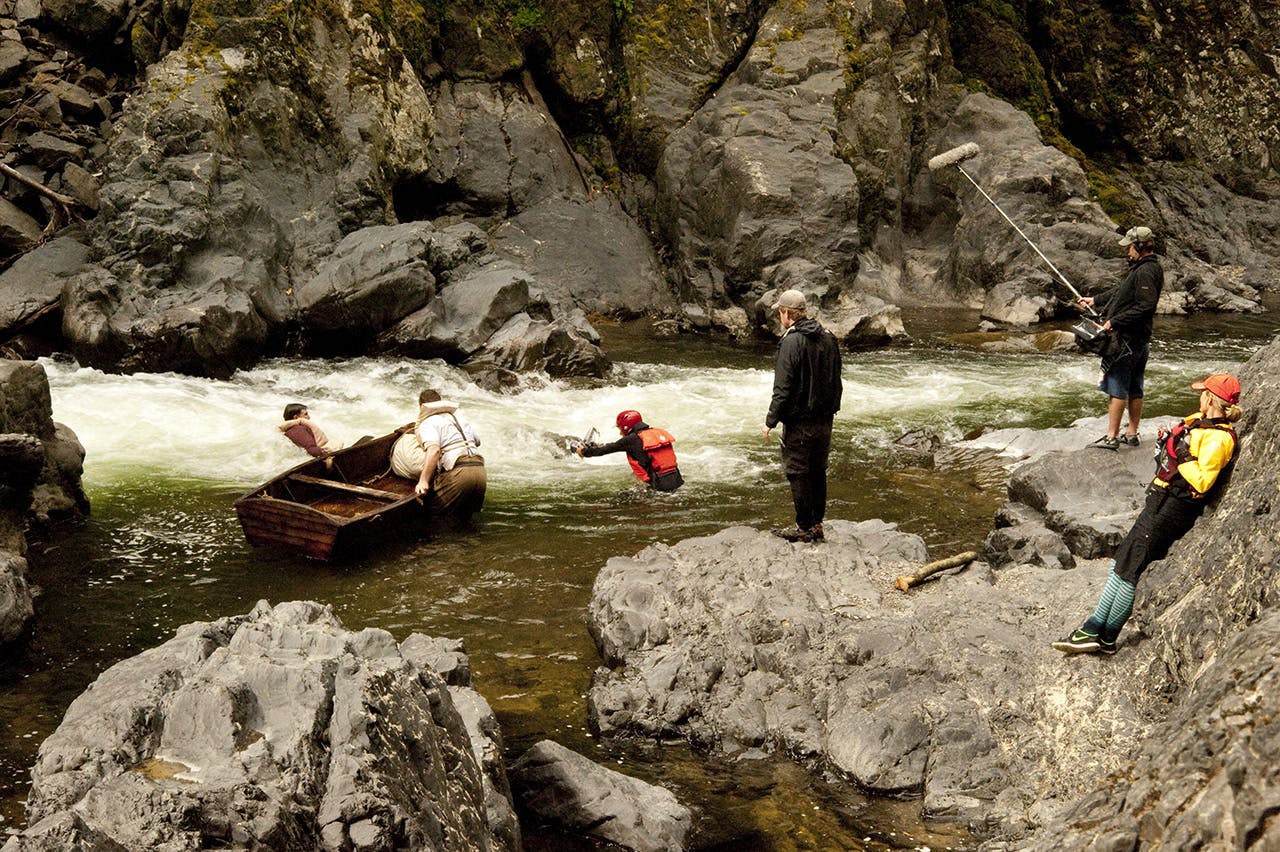
The film crew watch as Kevin and Jamie capsize their punt on the Motu River. Photo: Shaun Barnett/Black Robin Photography
Motu River descent, Raukumara Forest Park
When five men and their dog went to row the Motu in 1920, none of them knew what to expect. The boating party, which included the two Fisher brothers, thought perhaps it might take them a few days; it took 10. Paddling through treacherous rapids, or laboriously portaging around the worst sections, the adventurers lost one of their three wooden punts in one of the river’s many gorges. At times, the dog abandoned ship and walked. It was an adventure inspired perhaps by post-war enthusiasm, and a daring first descent of the mighty Motu.
In January 2013, the First Crossings crew set out to replicate this trip. When Kevin Biggar and Jamie Fitzgerald pushed off in their specially made wooden punts, I certainly wasn’t envious. Some of the Motu’s rapids are mean and as part of the support crew, I was happy to be in a modern inflatable raft.
To match the historic story, Kevin and Jamie had to smash one of their two boats. This would require some staging, or so we thought. Almost without warning and totally unscripted, the Motu decided to claim the boat on the second day. It happened in a fairly benign-looking rapid, when Jamie slewed sideways on to a large boulder, and the gunwale submerged. Despite freeing it once, the boat soon became wrapped around another rock. By now it was impossibly heavy with the weight of the water and the flow soon buckled the boat. Timbers splintered and the punt began breaking apart almost before cameraman Murray Milne could film its final disintegration.
There were still two gorges and a serious amount of mileage through which to nurse the remaining wooden boat. The sense of isolation proved both daunting and wonderful; the forested gorges rose above us, the rocks were often slick with rain and the relentless river poured through its narrow passageway. While low river levels offered some advantages, it required some technical rafting to get through tight spots. Finally, after five days of paddling, we arrived at the road bridge, the ocean just downstream.
At the end of their 1920 trip, the Fisher brothers and crew were warmly greeted by local iwi, who provided a hospitable feast. In return, the brothers gave their two remaining boats to the Maori. Our crew were also warmly treated by locals, including Sam, the doctor at Opotiki, who organised a barbecue. The helicopter pilot who took Murray back upriver for aerial shots was a local, too. When his whanau expressed interest in the wooden punt, we gave it to them.
At serendipitous moments like these, it’s almost tempting to believe that history occasionally repeats itself.
– Shaun Barnett
Remarkable achievement overshadowed by controversy
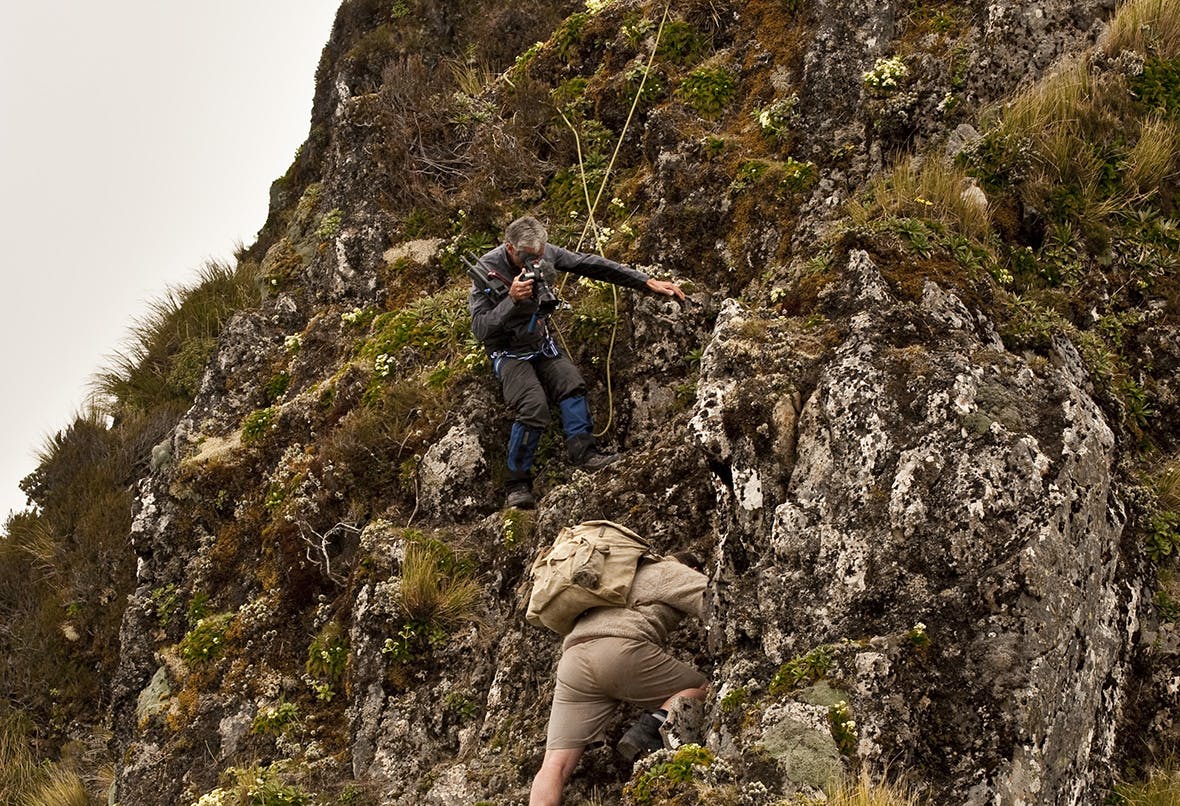
Cameraman Murray Milne films Jamie Fitzgerald during the reenactment of the Sutch search. Photo: Shaun Barnett
Sutch Search, Tararua Range
There were numerous parallels between our own filming experiences in the Tararua Range, and the weather conditions encountered by the so-called Sutch party of 1933. This group of four trampers, Morva Williams, Bert O’Keefe, Eric Hill and Bill Sutch, became the subject of a massive search while attempting the Northern Crossing. An accident forced them off the tops and into the Waiohine Valley where, in appalling conditions, they endured 10 days of arduous gorge travel, surviving on minimal rations and using all their bushcraft skills. Somehow, they eluded the hundreds of searchers looking for them.
The event, which became known as the Sutch Search, was one of the most controversial of the 20th century. Near starved, the party finally emerged onto farmland two weeks after setting out. At a subsequent public meeting, Hill made the unfortunate comment ‘We were never lost’ while Sutch added, ‘And we were never found’. To the searchers, some of whom had risked their lives, this seemed ungrateful. The media had a field day, castigating the four and reporting damning comments by well-known trampers of the day.
In November 2013 we were enjoying a flawless day near the Waiohine Pinnacles, filming the opening shots. Kevin and Jamie had strolled over typical Tararua tops, wearing their Bergen kidney-crusher 1930s packs, enjoying just the sort of conditions experienced by the Sutch party. But by the time we relocated to shoot scenes at the Broken Axe Pinnacles, where Bert O’Keefe had a nasty fall, the weather had deteriorated viciously. As Kevin and Jamie clambered up the rocky ramparts, hail fell between periods of lashing rain. O’Keefe’s fall had occurred after high winds forced the party off the ridge and onto a steep sidle, where he lost his footing. The terrain is steep enough to require safety ropes for the crew and, at one point, Mark Watson and I, on belay, were pulled off our stance. Fortunately, the anchors held and only one scuffed knee resulted. It’s a reminder that the Tararuas always deserve respect.
At Totara Flats, the Sutch party marched past Sayer Hut, where searchers were based, without seeing either the hut or the chimney smoke across the river. In almost identical weather, cloudy with intermittent rain, our replica fire was almost impossible to see from the far bank, despite Mark and I piling on wet grass to make it extra smoky.
In the river’s lower reaches, the increasingly dirty Waiohine forced us to film on the true left, as we couldn’t safely ford to the true right; an exact reversal of the Sutch party’s fate, who were trapped on the true right.
Each night we debated the Sutch story. Did they make stupid mistakes? The party suffered almost as much from media scrutiny as they did from their actual ordeal. However, after retracing the same ground, most of their decisions made perfect sense.
We concluded that the Sutch party’s remarkable achievement of traversing the length of the Waiohine was sadly overshadowed by the resulting controversy.
– Shaun Barnett
Survival against the odds
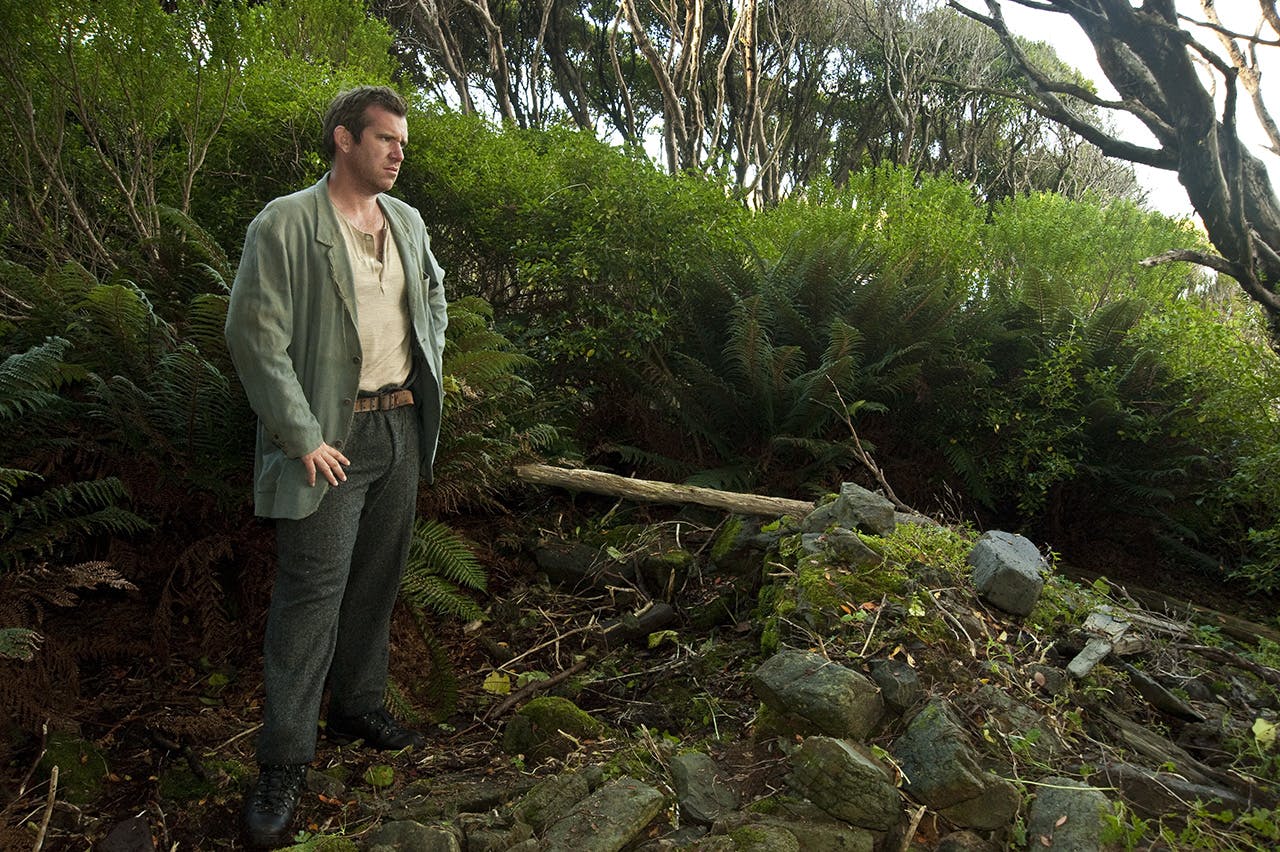
Jamie Fitzgerald at the ruins of Epigwaitt Hut on the Auckland Islands. photo: Shaun Barnett
Wreck of the Grafton, Auckland Island
It’s 150 years since the Grafton was wrecked in remote Carnley Harbour, marooning the five crew on this most inhospitable of subantarctic islands. But survive the men did, for 18 months, by building their own hut, named Epigwaitt, using stone and timber adzed from the twisted rata forest.
When no one came to rescue the men, three of them, led by Captain Musgrave, sailed the ship’s rowboat to Stewart Island. The other two were left to wait and see if Musgrave would return.
The Intrepid NZ crew sailed to the Auckland Islands in February 2014 aboard the 25m Evohe, anchoring just offshore from where the remains of the Grafton still lie exposed at low tide. There’s little left except for the keel and some protruding wooden ribs. Of Epigwaitt, only a mound of stones signalled its location in the forest.
At the ruins, I sat in the forest, keeping quiet while Murray filmed Kevin and Jamie recounting the historic moment of Mugrave’s return. Having thought they would be forever marooned, the two men were astonished to see Musgrave appear at the hut after weeks of absence. One of them, overcome with emotion, could only repeat again and again ‘Captain Musgrave, how are ye? How are ye?’
When Kevin recounted these words, a shiver ran up my spine. There we were, 150 years on, at the exact same site as the Grafton survivors, and the words still had emotional power.
At moments like this, you feel that history is alive.
– Shaun Barnett





